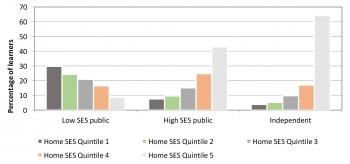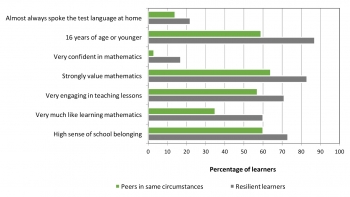Rising above: What makes a learner resilient?
Sometimes, a child from a poor background does well in mathematics despite their relatively adverse educational environment. They are known as resilient learners, young people who attend low socio-economic status public schools, fall within the three lowest quintiles of home socio-economic status, but nevertheless achieve above average scores for mathematics. In 2015, these learners comprised 12.5% of the South African grade 9 school population. Ncamisile Zulu and Dr Mariëtte Visser investigated the characteristics of resilient learners by using the TIMSS 2015 data. The results show that resilient learners are age-appropriate for their grade (i.e. have not repeated grades) and positive about their school, teachers and about learning mathematics.
Mathematics is relevant in people’s daily lives and often a requirement for skilled jobs that grow the economy. The subject offers various benefits to learners, such as improving their problem solving ability, logical reasoning, critical thinking, concentration and self-esteem. It also heightens stronger mental visualisation skills and increases memory power while sharpening learners’ overall mental formation. Having the right attitude and behaviour towards mathematics plays a key role in a learner’s performance. Attitudes are based on the values, beliefs and knowledge that the learners have about mathematics. Positive attitudes towards mathematics are more likely to yield positive behaviour towards the subject.
Resilience in learners
Despite extensive literature that associates children who come from low home socio-economic status (SES) with poor mathematics performance, some poor but resilient learners triumph above their circumstances and perform well in mathematics. Resilient individuals primarily focus on how they can attain positive outcomes regardless of challenging and threatening circumstances. In the midst of challenges, resilient young people are able to use their problem-solving expertise and maintain their internal locus of control and value-driven behaviour. Research shows that characteristics of resilient students include active participation in educational activities, mathematics self-efficacy (belief in one’s ability to perform a specific task), self-confidence (belief in one’s personal worth and likelihood of succeeding) and a positive attitude towards school. Additional skills include good stress management, goal setting, understanding motivation, and making strong connections with adults and peers.
What did we learn about resilient students from TIMSS?
Figure 1 provides a helicopter view of the distribution of the grade 9 learners, who participated in the TIMSS 2015 study, across school type (low SES public, high SES public and independent schools) and home asset-based socio-economic status (home SES). A learner was categorised as resilient if the learner attended a low SES public school, fell within the lowest three home SES quintiles and performed above the average mathematics score of 372 points. Of the total population of grade 9 learners, 48% attended low SES public schools and fell within the lowest three home poverty quintiles. Only 12.5% of the total population of grade 9 learners could be classified as resilient learners.
For the purpose of comparison, grade 9 learners who attended low SES public schools and who fell within the lowest three home SES quintiles were divided into two groups: resilient learners (learners who achieved scores at or above the mathematics average: ≥ 372 score points) and their peers (learners who performed below the mathematics average: < 372 score points).
The group of resilient learners included slightly more girls (52%) than boys (48%). The difference in mathematics performance between resilient boys and girls was not statistically significant. Eighty-seven percent of the group of resilient learners were 16 years of age or younger, compared to 59% of their peers. Researchers found that, in general, learners who often spoke the language of learning and teaching at home, usually performed better in school. Only 22% of resilient learners always or almost always spoke the language of the test at home compared to 14% of their peers who were living and learning in the same socio-economic conditions. Another factor that is positively associated with performance, is the education level of either parent. In general, parents with qualifications of matric or higher are able to assist their children with homework and learners in these households usually perform better. There was no difference between the parental education levels of resilient learners and their peers. A third of both groups had a parent with a qualification of higher than matric.
FIGURE 1: PERCENTAGE OF LEARNERS BY SCHOOL TYPE AND HOME SOCIO-ECONOMIC STATUS QUINTILE
FIGURE 2: PERCENTAGE OF LEARNERS IN THE TWO GROUPS BY SELECTED CHARACTERISTICS
How are they different?
Figure 2 depicts the main differences between resilient learners and their peers.
The analysis showed that resilient learners consistently reported higher levels of positive attitudes and behaviours compared to their peers. The differences between the group of resilient learners and their peers were statistically significant for all characteristics.
The data showed that 73% of resilient learners compared to 60% of their peers had a high sense of school belonging. They were proud of their school, liked being at school, felt safe at school, looked forward to seeing their classmates and perceived their teachers as being fair. Sixty percent of resilient learners compared to 35% of their peers liked learning mathematics very much. Another important attribute that contributed to better performance was engagement in classroom instructions. The study found that 71% of resilient learners, compared to 57% of their peers, positively and highly engaged in the mathematics teaching lessons and had positive attitudes towards their teachers. More attention is also usually given to subjects that are strongly valued. Eighty-three percent of resilient learners compared to 64% of their peers strongly valued mathematics and perceived it as a valuable subject for daily life, university entrance and to get the job they want in future. Although all resilient learners performed at or above the average score of all learners in grade 9 for mathematics, only 17% of them compared to 3% of their peers were very confident in mathematics.
Conclusion
Attitudes are shaped by experience or upbringing, and they can have a strong influence on a person’s behaviour. The performance of learners in mathematics is associated with their attitudes and behaviour. Factors such as having a high sense of school belonging, enjoyment in learning mathematics, engagement in teaching lessons and valuing mathematics all contribute to higher performance in mathematics, especially for learners who attend low SES public schools. This means that learners from low SES homes can also succeed in mathematics, provided they possess and apply resilient characteristics and skills in their school work. Therefore, we recommend that schools invest in and support interventions to promote learner attributes such as self-efficacy, self-confidence and positive attitudes towards their school, teachers and learning subjects such as mathematics.
Authors: Ncamisile Zulu, a PhD research intern, and Dr Mariëtte Visser, a senior research manager in the HSRC’s Education and Skills Development research programme.
mmvisser@hsrc.ac.za and nzulu@hsrc.ac.za


